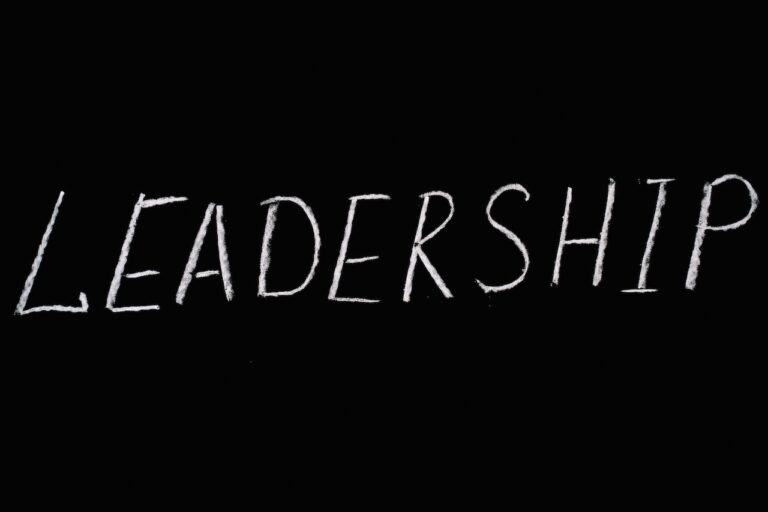From Poor to Great: The Dichotomy of Leadership
Understanding the Characteristics of Poor and Great Leaders
Effective leadership is crucial for the success of any organization, whether it is a small business, a non-profit, or a large corporation. However, not all leaders are created equal. There is a stark contrast between the characteristics and behaviors of poor leaders and great leaders. Understanding this dichotomy is essential for anyone aspiring to become an effective leader or for those seeking to improve their leadership skills.
Poor leaders are individuals who possess certain characteristics that make them ineffective at leading a team. These characteristics include bossing others around, micromanaging, blaming others, looking to be served, and seeing themselves as being above others. Such leaders often create a toxic work environment, leading to low morale, high turnover, and poor performance.
On the other hand, great leaders are individuals who possess certain characteristics that make them highly effective at leading a team. These characteristics include leading by example, empowering others, taking accountability, selflessly serving others, and recognizing that everyone is in this together. Such leaders create a positive work environment, leading to high morale, low turnover, and high performance.
In this article, we will explore the dichotomy of leadership and provide insights into how to develop great leadership skills. We will delve into the characteristics and behaviors of poor leaders and great leaders, the impact of their leadership styles on team morale and productivity, and strategies for overcoming poor leadership. We will also discuss the importance of emotional intelligence in effective leadership and how leaders can develop their leadership style. By the end of this article, you will have a better understanding of the dichotomy of leadership and how to become an effective leader that positively impacts your team and organization.
Poor Leaders
Poor leaders are individuals who possess certain characteristics that make them ineffective at leading a team. These leaders have a tendency to boss others around, micromanage, blame others, look to be served, and see themselves as being above others.
Firstly, poor leaders tend to boss others around. They use their authority to command their team members and do not take into consideration the thoughts and opinions of their team. This behavior creates a toxic work environment where team members feel undervalued and unappreciated.
Secondly, poor leaders micromanage their team members, creating a lack of trust and autonomy within the team. They fail to delegate tasks effectively, leading to a feeling of being overworked and undervalued. Micromanaging also leads to a lack of innovation and creativity as team members do not feel empowered to take risks and try new ideas.
Thirdly, poor leaders blame others for their mistakes and shortcomings. They fail to take accountability for their actions and instead shift the blame to their team members. This behavior creates a culture of fear where team members are afraid to take risks or try new things, leading to stagnation and lack of growth within the organization.
Fourthly, poor leaders look to be served instead of serving others. They have a self-centered mindset and prioritize their own needs above the needs of their team. This behavior leads to a lack of trust and respect within the team and creates a culture of disengagement.
Finally, poor leaders see themselves as being above others. They believe that their authority gives them the right to make decisions without consulting their team members. This behavior creates a culture of hierarchy and reduces the effectiveness of the team as team members feel undervalued and unappreciated.
The impact of poor leadership on team morale and productivity can be severe. Poor leadership can lead to a lack of trust, low morale, high turnover, and poor performance. It can also create a culture of fear, stagnation, and disengagement.
Examples of poor leadership can be found in various contexts, including businesses, non-profit organizations, and government agencies. One example of poor leadership is the case of Wells Fargo, where the company was fined $185 million for creating fake bank accounts and credit cards in the names of their customers. The company’s leadership failed to take accountability for their actions and instead blamed their employees for the fraudulent behavior.
Poor leaders possess characteristics that make them ineffective at leading a team. They boss others around, micromanage, blame others, look to be served, and see themselves as being above others. The impact of poor leadership can be severe and can lead to a lack of trust, low morale, high turnover, and poor performance. It is important to recognize these behaviors in oneself and take steps to overcome them in order to become an effective leader.
Great Leaders
Great leaders possess certain characteristics that make them highly effective at leading a team. These leaders lead by example, empower others, take accountability, selflessly serve others, and recognize that everyone is in this together.
Firstly, great leaders lead by example. They model the behavior they expect from their team members and set the standard for excellence. They are consistent in their actions and hold themselves to the same standards as their team members. Leading by example creates a culture of accountability and high performance within the team.
Secondly, great leaders empower others. They delegate tasks effectively and trust their team members to make decisions. This behavior leads to a sense of autonomy and ownership within the team, creating a culture of innovation and creativity. Empowering others also leads to a sense of trust and respect within the team, which increases morale and productivity.
Thirdly, great leaders take accountability. They take responsibility for their actions and do not shift the blame onto others. This behavior creates a culture of honesty and transparency, which increases trust and respect within the team. Taking accountability also leads to a sense of ownership within the team, which increases engagement and productivity.
Fourthly, great leaders selflessly serve others. They prioritize the needs of their team members above their own needs. This behavior creates a culture of respect and appreciation within the team, which leads to higher morale and productivity. Selflessly serving others also leads to a sense of loyalty within the team, which increases engagement and reduces turnover.
Finally, great leaders recognize that everyone is in this together. They see their team members as partners in achieving a common goal, rather than subordinates. This behavior creates a culture of collaboration and teamwork within the team, which leads to higher morale and productivity. Recognizing that everyone is in this together also leads to a sense of ownership within the team, which increases engagement and productivity.
The benefits of great leadership on team morale and productivity can be significant. Great leadership can lead to higher morale, lower turnover, higher productivity, and innovation. It can also create a culture of trust, transparency, and accountability, which leads to greater success for the organization as a whole.
Examples of great leadership can be found in various contexts, including businesses, non-profit organizations, and government agencies. One example of great leadership is the case of Patagonia, a clothing company that prioritizes environmental sustainability. The company’s founder, Yvon Chouinard, leads by example by living a minimalist lifestyle and using his wealth to protect the environment. The company also empowers its employees to take action on environmental issues and has a culture of transparency and accountability.
Great leaders possess characteristics that make them highly effective at leading a team. They lead by example, empower others, take accountability, selflessly serve others, and recognize that everyone is in this together. The benefits of great leadership can be significant and can lead to higher morale, lower turnover, higher productivity, and innovation. It is important to recognize these behaviors in oneself and take steps to develop them in order to become an effective leader.
Importance of Leadership Style
Leadership style refers to the way in which a leader interacts with their team members and how they make decisions. The impact of leadership style on team dynamics can be significant, and it is important for leaders to understand the different leadership styles and how they can affect their team members.
One of the most important aspects of leadership style is emotional intelligence. Emotional intelligence is the ability to recognize and manage one’s own emotions, as well as the emotions of others. Leaders who possess emotional intelligence are better able to communicate effectively, build trust, and make decisions that benefit the team as a whole.
There are several different leadership styles, including autocratic, democratic, laissez-faire, and transformational. Autocratic leadership involves making decisions without input from team members, while democratic leadership involves collaborating with team members to make decisions. Laissez-faire leadership involves giving team members autonomy and minimal guidance, while transformational leadership involves inspiring and motivating team members to achieve a common goal.
Each leadership style has its own strengths and weaknesses, and it is important for leaders to understand which style is best suited for their team and the situation at hand. For example, autocratic leadership may be necessary in a crisis situation where quick decisions need to be made, while democratic leadership may be better suited for a situation where team members have different expertise and input is necessary for making informed decisions.
Leaders can develop their leadership style by seeking feedback and coaching from their team members and peers. This can help them identify their strengths and weaknesses as a leader and develop a plan for improvement. Developing self-awareness as a leader is also important, as it allows leaders to recognize their own emotions and how they affect their interactions with others.
Leadership style plays a significant role in team dynamics and the success of an organization. Emotional intelligence is a crucial aspect of effective leadership, and it is important for leaders to understand the different leadership styles and how they can affect their team members. Developing self-awareness and seeking feedback and coaching can help leaders develop their leadership style and become more effective in their role.
Overcoming Poor Leadership
Overcoming poor leadership is essential for leaders who want to become effective at leading a team. Strategies for addressing poor leadership include developing self-awareness, seeking feedback and coaching, and adopting a growth mindset.
Developing self-awareness is a critical first step in overcoming poor leadership. Leaders must understand their own strengths and weaknesses and how their behaviors and actions affect their team members. This can be achieved through reflection and self-assessment, as well as through seeking feedback from team members and peers.
Seeking feedback and coaching is another important strategy for overcoming poor leadership. Feedback can help leaders identify areas for improvement and develop a plan for growth. Coaching can provide leaders with the tools and skills they need to become more effective at leading a team. It is important for leaders to be open to feedback and willing to make changes in their behavior and leadership style.
Adopting a growth mindset is also essential for overcoming poor leadership. A growth mindset involves a willingness to learn and improve, as well as a recognition that mistakes are opportunities for growth. Leaders with a growth mindset are more likely to take risks, seek feedback, and make changes in their behavior and leadership style.
In addition to these strategies, leaders can also benefit from developing their emotional intelligence. Emotional intelligence involves recognizing and managing one’s own emotions, as well as the emotions of others. Leaders who possess emotional intelligence are better able to communicate effectively, build trust, and make decisions that benefit the team as a whole.
It is important for leaders to understand that overcoming poor leadership is a continuous process. It takes time and effort to develop the skills and behaviors necessary to become an effective leader. However, the benefits of overcoming poor leadership are significant and can lead to higher morale, lower turnover, and greater success for the organization as a whole.
Overcoming poor leadership is essential for leaders who want to become effective at leading a team. Strategies for addressing poor leadership include developing self-awareness, seeking feedback and coaching, adopting a growth mindset, and developing emotional intelligence. It is important for leaders to understand that overcoming poor leadership is a continuous process that takes time and effort, but the benefits are significant and can lead to greater success for the organization as a whole.
Becoming an Effective Leader: Strategies for Overcoming Poor Leadership
Effective leadership is crucial for the success of any organization, and understanding the dichotomy of leadership is essential for anyone aspiring to become an effective leader or for those seeking to improve their leadership skills. Poor leaders possess characteristics that make them ineffective at leading a team, while great leaders possess characteristics that make them highly effective at leading a team.
Poor leaders tend to boss others around, micromanage, blame others, look to be served, and see themselves as being above others. The impact of poor leadership on team morale and productivity can be severe, and it is important for leaders to recognize these behaviors in themselves and take steps to overcome them.
Great leaders lead by example, empower others, take accountability, selflessly serve others, and recognize that everyone is in this together. The benefits of great leadership on team morale and productivity can be significant, and it is important for leaders to develop these behaviors and characteristics to become effective leaders.
Leadership style plays a significant role in team dynamics and the success of an organization. Emotional intelligence is a crucial aspect of effective leadership, and it is important for leaders to understand the different leadership styles and how they can affect their team members.
Overcoming poor leadership is essential for leaders who want to become effective at leading a team. Strategies for addressing poor leadership include developing self-awareness, seeking feedback and coaching, adopting a growth mindset, and developing emotional intelligence.
In conclusion, effective leadership is a continuous process that takes time and effort, but the benefits are significant and can lead to higher morale, lower turnover, and greater success for the organization as a whole. By understanding the dichotomy of leadership and developing effective leadership skills, leaders can positively impact their team and organization.






